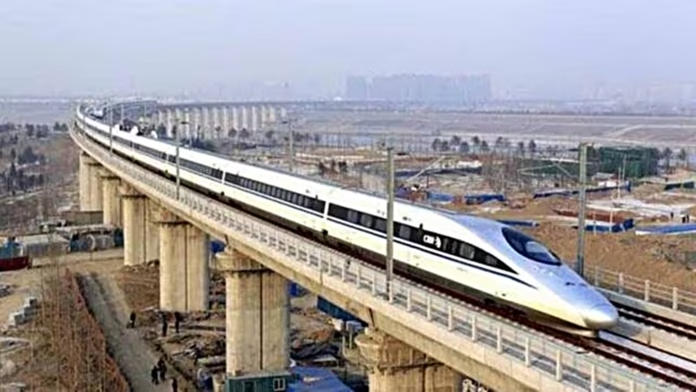India’s highly anticipated bullet train project between Mumbai and Ahmedabad is on track for an early operational launch, promising to reshape the nation’s railway infrastructure.
The Mumbai-Ahmedabad High-Speed Rail (MAHSR) corridor is one of the most ambitious initiatives undertaken by Indian Railways, set to deliver high-speed connectivity, reduced travel times, and a revolutionary shift in how India approaches modern transportation.
The project, which has seen rapid progress in recent months, is now in its final stages of development. A significant portion of the groundwork has already been completed, including the land acquisition and physical infrastructure development for over 320 kilometres of the route. With a major focus on reducing road congestion and enhancing commuter convenience, the bullet train is poised to serve as a game-changer, not only in terms of speed but also in terms of sustainability and eco-friendliness.
The first phase of the project will see trains operating at speeds of up to 280 km/h, with an average speed of 250 km/h. This is a dramatic leap compared to conventional trains, slashing travel times significantly. The bullet train will connect the two major cities, enabling passengers to travel the 508-kilometre stretch in under three hours, a journey that currently takes around seven to eight hours by road or conventional rail.
One of the key technological advancements of the Mumbai-Ahmedabad bullet train project is its integration of modern systems such as the Kavach 5.0, an automatic train protection system, which ensures safety and operational efficiency. This system, along with the advanced signalling technology, will help manage the high-speed rail operations safely and smoothly.
The ambitious plan also includes the production of bullet trains that will be built in India, further strengthening the nation’s capabilities in manufacturing high-speed trains domestically. While collaboration with international suppliers, particularly from Japan, continues, India is poised to independently produce future generations of bullet trains. This is an essential step towards making India a global player in the field of high-speed rail transport.Each of the bullet train coaches is set to cost approximately ₹28 crore, a price that reflects not only the high-quality design and development but also the cutting-edge technology involved in their manufacture. The Integral Coach Factory (ICF) and other domestic manufacturers have been tasked with ensuring that the trains meet international standards while being suited for India’s unique requirements.
As the civil works for the Mumbai-Ahmedabad corridor speed ahead, the Railway Board has also prioritised building the necessary infrastructure for future expansions. This includes the construction of stations, alignment works, and other essential facilities that will ensure the system runs smoothly and efficiently. The total expansion of the project is expected to cover over 400 kilometres, extending the reach of high-speed rail beyond this first iconic corridor.The government’s vision of a fast, efficient, and sustainable railway system goes beyond merely introducing high-speed trains. The bullet train initiative is expected to reduce carbon emissions significantly by shifting a substantial number of travellers from road to rail transport. This transition will not only ease traffic congestion but will also contribute to India’s long-term environmental goals of reducing greenhouse gas emissions, further supporting the country’s drive towards zero-net carbon urban development.
This project is part of India’s larger railway modernisation plan, which aims to transform the nation’s transport infrastructure into a world-class system that is not only efficient but also environmentally responsible. By building domestic capacity to manufacture bullet trains and expanding the network, India is well on its way to becoming a leader in high-speed rail transport.As the completion date draws nearer, the Mumbai-Ahmedabad bullet train project is generating considerable excitement. Once operational, it will redefine inter-city travel in India, making high-speed travel accessible to millions while supporting the nation’s aspirations for a sustainable, modern, and equitable transportation system. The project also signifies India’s growing capabilities in large-scale infrastructure development and its readiness to take on ambitious global projects.



